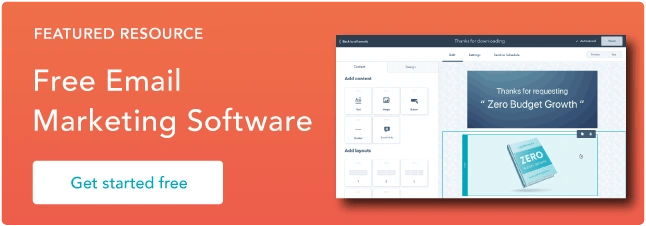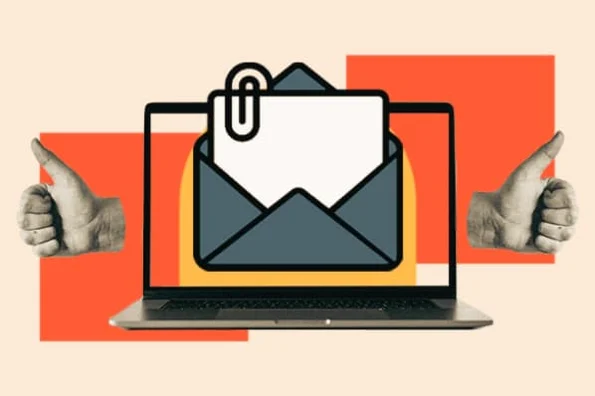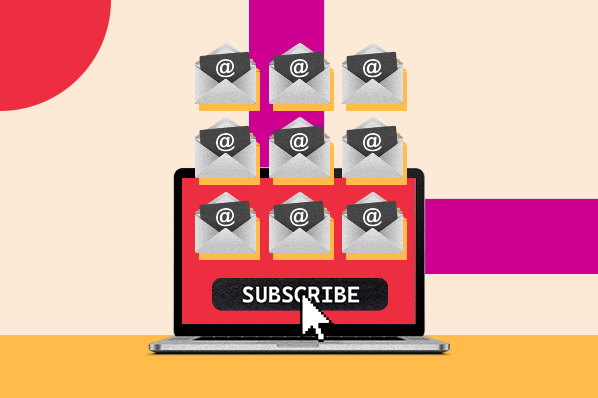Email marketing is continually evolving as subscriber preferences shift toward more personalized experiences. On average, 99% of people check their email every day, and the average email open rate is 17.61%.

However, that doesn’t guarantee your email will make the cut. Several factors impact email deliverability, opens, clicks, and conversions. So, what’s the first step to keeping your email KPIs strong? A clean email list. Clean email lists (with a great email marketing strategy behind them) will keep your email engagement high and your unsubscribe and spam rates low.
Why should you clean your email list?
- Limit unsubscribes.
- Decrease spam complaints.
- Improve deliverability.
- Improve a reduced open rate.
- Keep costs down.
1. Limit unsubscribes.
The more people on your email list, the higher the likelihood that some have lost interest in your email. It happens. It could be a good idea to review engagement and remove any subscribers who no longer seem interested before they hit the unsubscribe button.
2. Decrease spam complaints.
Spam complaints are bad for your reputation with ESPs. If your emails are constantly marked as spam, your ESP might flag your account for sending unwanted solicitations. If this happens too often, your deliverability rate can suffer.
3. Improve deliverability.
The cleaner your list is, the greater the number of subscribers who want to open it. On the other hand, a list full of people who don’t engage, have changed their email address, or worse, never opted in will result in spam filters and bounces — both of which can hurt your deliverability.
4. Improve a reduced open rate.
Quality over quantity is the goal here. If you start to see your open rate decline, take a look at your list and check for inactive subscribers. Of course, you’ll want to attempt a reengagement campaign before removing them. If that doesn’t work, you should consider retaining only your active subscribers.
5. Keep costs down.
Many ESPs tier their pricing by the number of emails you send. In order to keep your costs down, you’ll want to remove the subscribers who are receiving your emails and never opening them.
All of these add up to one big red flag — your email subscribers aren’t engaged (or aren’t getting your emails). When people unsubscribe from your email list they are actively opting out of receiving your emails. If several of your emails get marked as spam, your deliverability rates will suffer.
Open and click through rates tell you how many of your subscribers are opening the email you sent, clicking on a link, and ultimately, if they’re interested in the content you’re sharing.
Making sure your email lists are clean and targeting the right audience increases your ROI and decreases the chances of your marketing emails being flagged as spam. Cleaning up your email lists gives you a better chance to reach and engage your audience.
How often should you clean email lists?
The short answer is at least once a year. However, email cleaning depends on your company and how large your list is. When looking at how often to clean your lists, review your open rate and clickthrough rate, unsubscribes, and spam rates. This will give your company a clear picture of who is engaging with your campaigns and what they’re interested (or not interested) in.
You also want to consider the number of subscribers coming in every quarter — if it’s high, you might want to check your lists more often. If you’re seeing a high number of bounces, then that’s an indicator that it’s time to clean your email list.
Every company is different so clean up can happen monthly, quarterly, bi-annually, or annually but it should be done at least once a year.
How do you clean (or scrub) an email list?
- Identify disengaged subscribers.
- Identify reasons for bounces.
- Try to reengage inactive subscribers.
- Segment your list and remove inactive subscribers.
1. Identify disengaged subscribers.
Before you scrub your list, you’ll want to identify whether a subscriber is truly inactive or simply disengaged. The former could mean you’ll need to remove them, while the latter might mean you still have a chance to win them over. A disengaged subscriber might just need some more targeted marketing to refresh their interest in your emails. After all, they did subscribe to your list at some point.
To do this, you’ll need to set some criteria for what “disengaged” means. Have they not opened an email in three months? One year? Have they not engaged with any campaigns? Have they not clicked on any links in six months?
Once you’ve identified your disengaged subscribers, you’ll want to place them in a separate list, filter for common themes, and identify a strategy to pique their interest. That could mean a discount code, a personalized subject line, or some other engagement strategy. The point is: before you write off these subscribers, give reengagement your best shot.
If reengagement doesn’t work, then you can truly mark the subscriber as disengaged and inactive.
2. Identify reasons for bounces.
Bounce rates are terrible for email deliverability, but not all bounces are created equal. There’s a difference between a hard bounce and a soft bounce. The former is a permanent issue, like an inactive email, and the latter is a temporary problem, like a full inbox.
You’ll need to remove emails that have a hard bounce, but keep an eye on soft bounces, as the problem could resolve over time.
3. Check for spam filters.
You’ll want to remove any subscribers that mark your email as spam immediately. Spam filters hurt your deliverability and your reputation. If a subscriber no longer finds your emails helpful, or worse, sees them as spam, then it’s best to part ways by removing them from your list.
4. Clear out inactive subscribers.
The final step in cleaning out your email list is to create separate lists for all the categories above and remove the emails from your list that are no longer active. It might be hard to part ways with these emails, but, in the end, you’re doing your deliverability and engagement rates a huge favor.
Email List Cleaning Best Practices
- Make sure your list has good hygiene.
- Consider using double opt-ins.
- Manage bounce rate.
- Use automation.
- Provide an “opt down” option.
- Understand your email audience.
- Remove inactive subscribers.
1. Make sure your list has good hygiene.
The key to a squeaky clean list is to have a great routine and stick with it. Create a schedule for cleaning up your lists by looking at your data quantity and quality. This will determine how often you will have to clean your list. No matter how big your list, if most of your subscribers are not interacting with your emails, it is time to assess why.
When looking through your email lists, check for duplicates, typos, and email addresses that have the word “spam” in them so that your emails are getting sent to the right person and are not bouncing. ”
2. Consider using double opt-ins.
A double opt-in is a way to ensure that your subscribers truly want your email. Here’s how it works: once a user submits their information to a form on your site, an email is sent to confirm their subscription. This does a few things: it gets them used to opening your emails, it signals to their email provider that your emails should not be automatically marked as spam, and it gives you an opportunity to ask them to save your contact info so emails don’t get lost. All around, a win.
3. Manage bounce rate.
Bounced emails happen when there is a typo in the email address, if the email no longer exists, or for a number of other reasons. Checking for bounced emails can increase your deliverability and email ROI. Email bounces are broken down into two categories: soft and hard bounces.
A soft bounce is a temporary deliverability problem, such as a full inbox or a server that is down. Resending emails to these addresses can be beneficial because they can go through eventually.
A hard bounce happens due to permanent deliverability problems, such as an invalid email address. When you have hard bounces it is imperative to remove these addresses from your lists to keep your Email Service Providers (ESPs) happy. ESPs track the number of bounces you generate with each send and use it when determining your email credibility. Getting too many hard bounces is equivalent to people automatically putting your emails in the Spam folder.
4. Use automation.
Marketing automation is for emails, too. You can have your CRM automatically send subscribers to certain lists (or tag them) based on their actions. Remember when we discussed moving inactive subscribers to a separate list? Well, instead of doing this manually, you can set up an automation that does this for you and triggers a reengagement campaign. Another way you can use automation is to remove subscribers from email workflows or campaigns that are no longer applicable to them.
5. Provide an “opt down” option.
Have an “opt down” option in addition to an "opt out" option. An “opt down” option lets your subscribers choose how often and which emails they want to receive from you. Unfortunately, subscribers can forget that they subscribed to your email lists, increasing the chance that they will delete, unsubscribe, or put you straight in the Spam folder — all undesirable outcomes. Providing an “Opt Down” option provides an opportunity for the subscriber to stay on your list without the overwhelm of receiving correspondence they don’t want.
6. Understand your email audience.
Before cleaning out your email list, take stock of how much your current audience aligns with your ideal audience. Look for ways to re-engage inactive subscribers by separating them into lists based on their interests and demographics. For example, you could create engaging welcome emails for new subscribers or whip up a discount campaign for older subscribers. Having multiple lists helps you to create campaigns that’ll drive conversion rates up.
All in all, the success of email marketing campaigns should not be measured by the number of subscribers but by the quality of the subscribers and the actions they take as a result of your email. Therefore, it’s better to deploy campaigns to 20,000 active and engaged people than it is to blast the email to 30,000 people if half of them don't care, will delete it, or worse, report it as spam.
7. Remove inactive subscribers.
Inactive subscribers are those who do not open, click, or engage in your emails in any form. Having engaged subscribers will always be beneficial to your conversion rates, so by removing inactive subscribers you will drive up your open and click through rates for your campaigns.
Before you remove inactive subscribers permanently you can try sending them one last email campaign that could be a feedback campaign to see what will re-engage them. If all fails you’ll need to permanently delete them as subscribers to not hurt your email deliverability and conversion rates.
Start Cleaning Out That Email List
Email marketing is essential to any industry and doing a routine clean up can be beneficial to your company’s data reports and conversion rates. As long as you’re performing routine clean ups, maintaining your open and click through rates, managing bounce and spam rates, and engaging your lists with targeted emails of their interest, you will always have a squeaky clean email list.
Editor's note: This post was originally published in October 2011 and has been updated for comprehensiveness.



![Creating an HTML Email: The Design Guide You Need [+ Free Templates]](https://blog.hubspot.com/hubfs/html%20design.png)
![Email Analytics [Research]: 8 Email Marketing Metrics You Should Track](https://blog.hubspot.com/hubfs/Untitled%20design%20%2851%29.jpg)


![How to Create a Product Launch Email [Outlines + Templates]](https://blog.hubspot.com/hubfs/create-a-product-launch-email_5.webp)

![16 Great Examples of Welcome Emails for New Customers [Templates]](https://blog.hubspot.com/hubfs/36_Welcome%20Email%20Templates.jpg)
![How to Embed Video in Email [Quick Tip]](https://blog.hubspot.com/hubfs/embed-video-in-email.jpg)
![23 Email Marketing Tips to Improve Open & Clickthrough Rates [+HubSpot Blog Data]](https://blog.hubspot.com/hubfs/make-emails-more-clickable_8.webp)